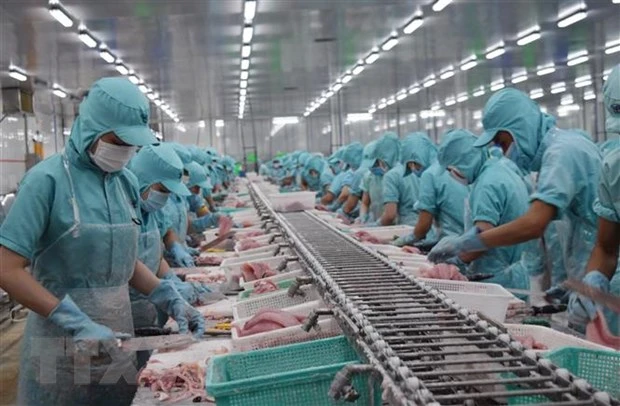
Opportunities only in theory
In April 2020, exports were heavily impacted by the Covid-19 pandemic. Export turnover to major markets had decreased, in which the EU market fell by 28.6%. It is expected that in May and June, the situation will not be very satisfactory either because the canceled and delayed orders are still pending. Even when the Covid-19 pandemic is under control in Europe, it will be difficult for export industries such as textiles, leather, shoes or furniture to bounce back because the demand for fashion or furniture after the pandemic ends will not be a priority. This means that the push from EVFTA will not come this year for many commodity groups.
Once EVFTA takes effect, fruits and vegetables will be one of the agricultural products that will benefit. Accordingly, the EU is committed to open very strongly for Vietnamese vegetables and fruits by eliminating 94% of the total 547 tariff lines for vegetables and fruit products immediately, including many products that are strengths of Vietnam such as lychee, longan, rambutan, dragon fruit, pineapple, and melons. Most EU tariff lines will be abolished right away and have an average MFN tax rate of about 10%. There are fruits and vegetables that are subject to tax rate of about 20% also. Thus, this level of commitment will create a great price advantage for Vietnamese vegetables and fruits, especially in competition with other countries with the same non-FTA sectors such as Thailand, China, Malaysia and Indonesia.
According to statistics of the Vietnam Fruit and Vegetable Association (Vinafruit), the proportion of exports to the EU account for only 3-5% of the total export turnover of the whole industry. With the tax rate decreasing to 0%, turnover is forecast to grow strongly. But it is a theoretical calculation. In fact, to enter the European market we have to go through very strict technical procedures.
Mr. Dang Phuc Nguyen, General Secretary of Vinafruit, affirmed that the requirements on food hygiene and safety, chemical residues and plant protection drugs in Europe are very strict and Vietnamese goods must first receive Global GAP certification to enter. Currently the area of growing vegetables and fruits under Global GAP certification in Vietnam accounts for only 5-10% of total area. The conversion requires time, capital and the support of the State.
Meanwhile, shrimp is one of the products that enjoy many advantages from EVFTA. Specifically, frozen black tiger shrimp will reduce from 20% tax to 0% right after the agreement comes into effect. Other shrimp products will reduce as per the three to five-year schedule. This will contribute to increasing competitiveness in our shrimp products to the EU compared to competitors such as Thailand and India, which are not entitled to preferential tax rates.
However, according to Mr. Ho Quoc Luc, General Director of Sao Ta Food Company, the advantage is still in theory because we have not resolved many internal bottlenecks. Shrimp entering the EU must have a source of ASC standard, while the current ASC farming area is still very modest.
Concerns over standards of origin
According to many experts, although EVFTA takes effect right from the beginning of the third quarter, industries such as textiles and footwear will hardly get a big push. Currently, Europe is ranked 2nd in Vietnam's textile and apparel import market, however, a new issue of the textile industry is to meet the standards of origin.
Accordingly, in order to be eligible for a tax reduction under the agreement, the product must strictly follow the rules of origin and satisfy the two conditions, namely, fabric used to produce finished products must originate from Vietnam or EU and cutting and sewing must be done in Vietnam or EU. However, EVFTA also has a flexible commitment to cumulative rules of origin.
Specifically, if enterprises use fabrics originating from countries with FTAs, their products are also considered valid origin to enjoy tax incentives as prescribed by EVFTA. However, according to Mr. Pham Xuan Hong, Chairman of Ho Chi Minh City Textile and Garment Association, currently we still import the main materials from China, and very little from South Korea because this is not a big supply market of raw materials.
Of course, garment enterprises also expect that with EVFTA, investing or attracting investment in support industries for garment industry in Vietnam will have a chance to make a breakthrough. Because the initiative of raw materials will help businesses switch to goods with higher forms such as FOB or ODM, instead of simply processing with low value-added as today.
In order to remove difficulties for the fruit and vegetable industry, Mr. Dang Phuc Nguyen said that it is necessary to have agricultural research institutes to guide farmers on how to grow, research high-resistance crop varieties, and invest in importing or manufacturing micro-biological medicines to repel disease, so that it can transform the longstanding cultivation model of farmers.
For shrimps to reach EU standards, Mr. Ho Quoc Luc stated inadequacies which require building ASC shrimp farms over large areas and capital investment. Most shrimp farmers are now small scale so it is difficult to grow fast. In addition, rigorous standards of EU traceability have set many regulations and not all enterprises can meet such stringent requirements.




















